Remediation Potential of Andropogon tectorum in a Crude Oil Polluted Site Amended with Urea
| Received 19 Apr, 2022 |
Accepted 20 Sep, 2022 |
Published 31 Mar, 2023 |
Background and Objective: Environmental pollution resulting from oil spills during exploration and exploitation of petroleum resources in the Niger Delta Region is a major challenge in the development of the region. An investigation on the remediation potential of Andropogon tectorum in crude oil polluted soil amended with urea was conducted on a crude oil impacted farmland at Botem Tai. Materials and Methods: A Latin Square Design (LSD) was used for the experiment and the treatments were: P1(Phytoremediation soil without amendment), P2 (Phytoremediation soil with 20 g Urea amendment), P3 (Phytoremediation soil with 40 g Urea amendment) and P (Polluted soil without phytoremediation and amendment) which served as the control. Results: The result showed that Andropogon tectorum was tolerant to and had the potential for phytoremediation of crude oil polluted soil. The addition of urea significantly improved the potential of Andropogon tectorum as higher reductions in TPH (56.93 and 92.66%) and THC (76.52 and 95.81%) were obtained in phytoremediation soil amended with 40 and 20 g urea at 2 and 4 months, respectively as compared to TPH (1.34 and 14.76%) and THC (24.75 and 32.90%) recorded in the control (P). Results also showed that urea amendment increased the uptake and accumulation of hydrocarbon in Andropogon tectorum with the highest accumulation of TPH (1.79±0.01 and 2.68±0.02 mg kg‾1) and THC (4.45±0.56 and 26.97±4.11 mg kg‾1) in treatment with 40 g urea amendment. Conclusion: Andropogon tectorum amended with 20 g urea increased hydrocarbon reduction rate in crude oil polluted soil; showing its great potential in remediating crude oil polluted soil.
| Copyright © 2023 Keayiabarido et al. This is an open-access article distributed under the Creative Commons Attribution License, which permits unrestricted use, distribution, and reproduction in any medium, provided the original work is properly cited. |
INTRODUCTION
Oil spills on Niger Delta lands have been extensive and are no longer new to the inhabitant of the area1 hence, environmental pollution majorly resulting from the oil spills caused by crude oil exploration and exploitation2 activities predominant in the area3 is a common challenge of development in the region4,5. The unrefined petroleum resource contains contaminants such as hydrocarbon and other organic materials capable of altering the composition of the receiving media (air, soil and water).
These spills in the area have hindered agricultural and other activities as well as lively-hood in the affected environment6 due to the negative impacts7 on the soil and subsequent decrease in soil organic matter making soil conditions unfavourable for plant growth for several months and even years. This soil degradation eventually leads to food scarcity, hunger and several civil unrests recorded in the Niger Delta Region of Nigeria8.
The aforesaid consequences of the oil spill need to be remedied. Remediation is described as the management of contaminants at the site to avert, lessen or reduce harm to human health and the environment. Remediation could be done ex-situ or in-situ (on-site). Some remediation techniques include soil washing with chemical agents9,10, immobilization or stabilization of contaminants by addition of non-toxic material into the soil11, dilution method involving the mixing of the polluted soil surface with clean soil surface and phytoremediation.
Phytoremediation is the use of plants usually in association with microorganisms to remove, degrade and immobilize contaminants in soil12,13 and its efficacy is promising in the tropic due to the favourable climatic conditions prevalent in the area. Several plants have been found with the potential of remediating petroleum polluted sites. For instance, Chromolaena odorata had been reported for its potential for phytoremediation14. The purpose of this study is to evaluate the phytoremediation potential of Andropogon tectorum in crude oil polluted soil with or without urea amendment.
MATERIALS AND METHODS
Study area: The study was carried out on a crude oil polluted farmland at Botem in Tai Local Government Area, Rivers State, Nigeria. The study was carried out in the year 2018 from April to August. The polluted site was an the abandoned crude oil impacted site which lies at the intersection 4°43'32.7828"N, 7°16'3.8028"E.
Mapping of experimental plots and design: The study was conducted on a 14×10 m polluted site which was mapped out using a Latin square design. The site was subdivided into 16 sub-plots of 2×2 m each with an interval of 1m between them. A heap was used to demarcate the plots to prevent the exchange of materials between plots. Thus the experiment was made up of 4 treatments and each was replicated 4 times. The treatments were shown in Table 1:
P = Polluted soil without phytoremediation and amendment
P1 = Phytoremediation soil without amendment
P2 = Phytoremediation soil with 20 g urea amendment
P3 = Phytoremediation soil with 40 g urea amendment
| Table 1: | Experimental layout | |||
| P1 | P2 | P3 | P |
| Phytoremediation soil | Phytoremediation soil with | Phytoremediation soil with | Polluted soil without |
| without amendment | 20 g urea amendment | 40 g urea amendment | phytoremediation and amendment |
| P2 | P3 | P | P1 |
| Phytoremediation soil with | Phytoremediation soil with | Polluted soil without | Phytoremediation soil |
| 20 g urea amendment | 40 g urea amendment | phytoremediation and amendment |
without amendment |
| P3 | P | P1 | P2 |
| Phytoremediated soil with | Polluted soil without | Phytoremediation soil | Phytoremediation soil with |
| 40 g urea amendment | phytoremediation and amendment |
without amendment | 20 g urea amendment |
| P | P1 | P2 | P3 |
| Polluted soil without | Phytoremediation soil | Phytoremediation soil with | Phytoremediation soil with |
| phytoremediation and amendment |
without amendment | 20 g urea amendment | 40 g urea amendment |
Addition of urea: The 20 and 40 g m–1 of urea equivalent to 200,000 and 400,000 kg ha–1, respectively were dissolved in distilled water and applied on the soil surface of treatment plots P2 and P3, respectively. This was allowed for a month before planting the phytoremediation plant.
Planting: Young seedlings of Andropogon tectorum of the same age and size were collected from the wild and planted on treatment plots P1, P2 and P3, while plots P were left untouched. A minimum of 30 seedlings were planted per plot. The plants were allowed to grow and collected afterwards for analysis at two and four months after planting.
Sample analysis: Soil samples were collected from each plot (P, P1, P2 and P3) within a depth of 0-15 cm using a soil auger. The soil samples from the same plots were mixed to give a composite sample, each sample was put in a polythene bag, labelled according to the plots and taken to the laboratory for analysis. This analysis was done before treatment (at 0 months). Subsequently, at 2 and 4 months after treatment, plant samples and soil samples around the root zone of the plant in the treatment plots (P1, P2 and P3) were collected. Soil samples were also collected from the untouched subplots (P) and the analysis carried out in the laboratory on soil samples were: pH, conductivity, moisture content. Nitrogen, total organic carbon, total organic matter, potassium and phosphorus. Hydrocarbon analysis was also done on soil and plant samples. Soil pH and conductivity were determined using an electrode pH meter (PHS. 25 Model) and conductivity meter (Lab-tech Model), respectively.
The air oven method used by O’Kelly15 was used to determine soil moisture content where the weighed soil samples were dried in Gallenkamp air oven at a stable temperature of 105°C for 6 hrs, reweighed, recorded and subsequently calculated using the formula:
Where:
Fresh weight of sample |
= |
Weight of flask with moist sample |
Dry weight of sample |
= |
Weight of flask after drying minus weight of the empty flask |
Gas Chromatography/Mass Spectrometry (GC/MS) method cited by Faustorilla et al.16 was used to determine total petroleum hydrocarbon in soil and plant samples while the API-RP45 Colorimetric method used by Jude et al.17 was used to determine the Total Hydrocarbon Content (THC) of soil and plant samples. Walkley-Black method cited by Tanee and Jude14 was used to determine total organic carbon and Potassium in soil. Total organic matter in soil was calculated using the formula by Osuji et al18. To determine nitrogen in the soil the regular Kjeldahl Method outlined by Jude and Tanee19 was used. Phosphorus was determined using Bray-No. I method cited by Tanee and Jude14. Means and standard error means were calculated from the data generated and were further analysed statistically using a Two-way Analysis of Variance (ANOVA). The Least Significant Difference (LSD) was determined using the 2018 version of the Duncan Multiple Range Test and results were presented as Mean±Standard Error (SE) using histograms and a table.
RESULTS
Figure 1 and 2 show the effect of phytoremediation treatment on Total Petroleum Hydrocarbon (TPH) and Total Hydrocarbon Content (THC) of soil. The result showed significant reductions in TPH and THC of soil in all phytoremediation treatments (either with an amendment or without amendment) than the control, P (polluted soil without plant and amendment) at p = 0.05. However, the highest percentage of TPH (512.49 mg kg–1) and THC (687.15 mg kg–1) reductions were recorded in phytoremediation soil with 40 g urea amendment (P3) at 2 months while the control (P) had the least percentage reduction (1173.99 and 2202 mg kg–1) of TPH and THC respectively. At 4 months, phytoremediation soil with 20 g urea amendment (P2) recorded the highest percentage of TPH (87.32 mg kg–1) and THC (122.55 mg kg–1) reductions while the least percentage reductions in TPH (1014.37 mg kg–1) and THC (1963.67 mg kg–1) was obtained in the control (polluted soil without plant and amendment).
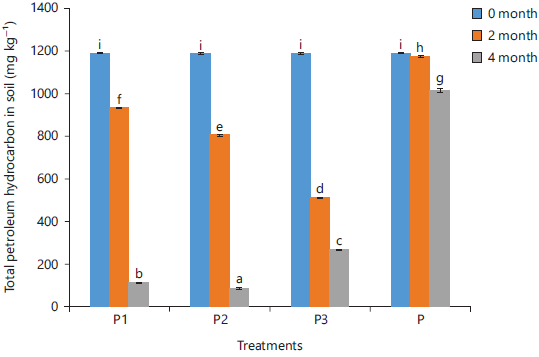
|
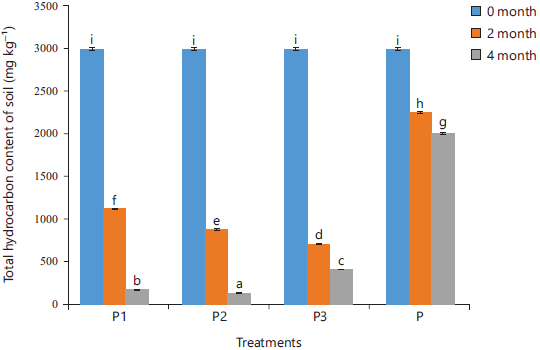
|
Figure 3 and 4 below showed results for pH and conductivity of soil in the different treatments. An increase in soil pH was observed in all the treatments at the end of the study (4 months) as compared to the pH value obtained initially (0 months). Generally, there was a decrease in soil acidity in all the treatments. However, the highest increase in soil pH (5.85) was recorded in treatment P3 (phytoremediation soil with 40 g urea amendment) and the lowest (5.02) was obtained in P (polluted soil without plant and amendment) at 4 months. There was a significant difference (p = 0.05) in soil pH of treatment P3 and other treatments at 4 months.
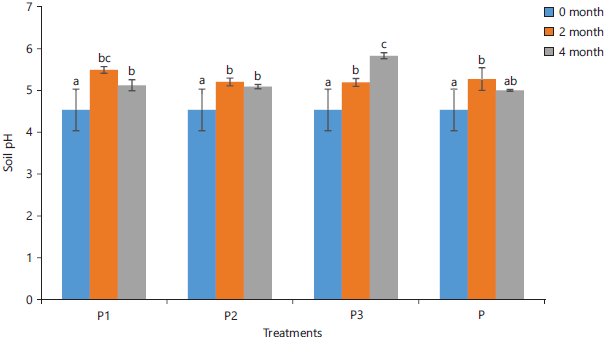
|
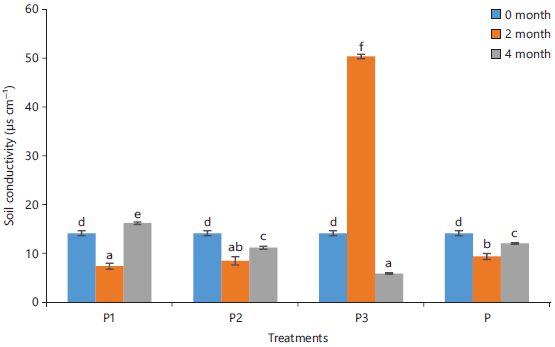
|
Results for soil conductivity showed that there was a significant difference in soil conductivity of treatment P3 and other treatments at both 2 and 4 months (p = 0.05). A decrease in conductivity was observed in the treatments: P1 (phytoremediation soil without amendment), P2 (phytoremediation soil with 20 g urea amendment) and the control, P (Polluted soil without plant and amendment) except in treatment P3 (phytoremediation soil with 40 g urea amendment) where conductivity increased at 2 months.
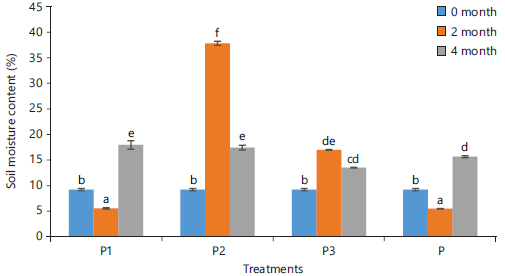
|
At 4 months, an increase in soil conductivity was observed in all treatments except in treatment P3 where a decrease was observed. However, the highest (50.40 μs cm–1) and lowest (7.37 μs cm–1) conductivity of soil was obtained in treatment P3 (phytoremediation soil with 40 g urea amendment) and P1 (phytoremediation soil without amendment), respectively at 2 months. The reverse was the case at 4 months with treatment P1 (phytoremediation soil without amendment) having the highest soil conductivity (16.20 μs cm–1) and the lowest (5.87 μs cm–1) in P3 (phytoremediation soil with 40 g urea amendment).
The effect of the different treatments on soil Moisture Content (MC) is presented in Fig. 5. An increase in moisture content of soil (37.89 and 17.02%) was recorded in all phytoremediation soil with urea amendment (that is, treatment P2 and P3) respectively while the decrease in soil Moisture Content (MC) was observed in phytoremediation soil without amendment (P1) and the control (P) at 2 months. At 4 months, a decrease in MC of soil was obtained in the phytoremediation soil with urea amendments (P2 and P3) while increases were recorded in phytoremediation soil without amendment (treatment P1) and the control (P) compared to that of 2 months. However, the highest soil moisture (37.89%) was recorded in P2 (phytoremediation soil with 20 g urea amendment) while the lowest (5.49%) was obtained in the control (P) at 2 months.
There was a significant difference in total nitrogen of soil of treatment P3 and other treatments at 4 months at p = 0.05 in Fig. 6. The highest nitrogen content of soil (3.3483%) was obtained through treatment P3 (phytoremediation soil with 40 g urea amendment) and the lowest in P (polluted soil without plant and amendment) soil the termination of the study (4 months).
Total Organic Matter (TOM) in Fig. 7 and Total Organic Carbon (TOC) in Fig. 8 increased in phytoremediation soil with an amendment; P3 at 2 months and P2 at 4 months compared to 0 months respectively. The highest total organic matter (4.3027%) and total organic carbon (2.4957%) were recorded in treatment P3 (phytoremediation soil with 40 g urea amendment) while the control (P) recorded the lowest TOM and TOC values (2.6170 and 1.5213%), respectively at 2 months. At 4 months, the highest TOM (3.6313%) and TOC (2.1057%) were obtained in treatment P2 (phytoremediation soil with 20 g urea amendment) and the lowest TOM (1.4597%) and TOC (1.5207%) was obtained in the control (P).
Figure 9 and 10 show the result for potassium and phosphorus in soil obtained in the different treatments. There was an increase in potassium in all treatments except in treatment P3 (phytoremediation soil with 40 g urea amendment) at 2 months (Fig. 9). At 4 months, increased potassium in soil was obtained in treatments P1 and P3 while treatments P2 and P recorded a decrease in potassium of soil as compared to the result obtained at 2 months. The highest increase in potassium (37.6567%) in soil was recorded in the control (P) at 2 months. However, at 4 months, the highest potassium (42.0800%) in soil was obtained in phytoremediation soil without amendment (P1). The lowest potassium content (26.6367 and 26.1133%) was obtained in treatment P3 and P2 at 2 and 4 months respectively. There was a significant difference (p = 0.05) between potassium in soil obtained in treatment P1 and other treatments at the end of the study (4 months).
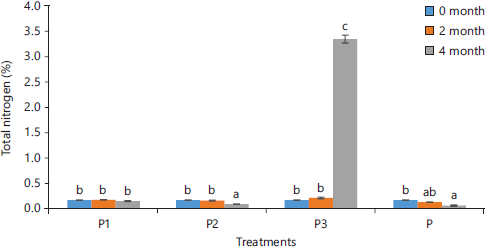
|
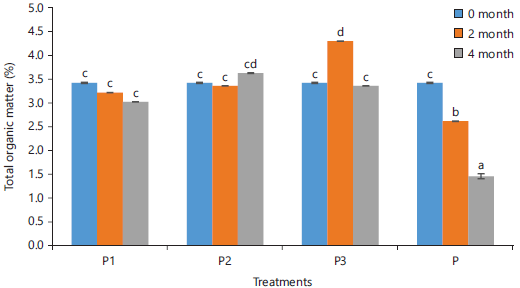
|
Phosphorus in soil increased in all the treatments with the control (P) having the highest phosphorus value (0.6867%) and the lowest (0.2867%) in phytoremediation soil with 40 g urea amendment (P3) at 2 months. There was a significant difference between increased phosphorus in the control (P) and other treatments p = 0.05. At 4 months, a decrease in phosphorus was observed in all treatments compared to the result obtained at 2 months.
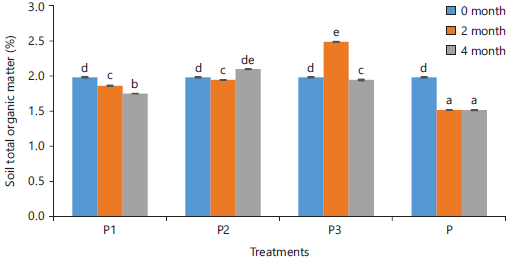
|

|
| Table 2: | Hydrocarbon accumulation in plant | |||
TPH in plant (mg/kg) |
THC in plant (mg/kg) |
|||
| Treatments | 2 months |
4 months |
2 months |
4 months |
| P1 | 0.56±0.05a |
0.97±0.03ab |
1.72±0.16c |
2.58±0.11d |
| P2 | 0.55±0.01a |
0.57±0.02a |
1.29±0.29a |
1.56±0.45b |
| P3 | 1.79±0.01c |
2.68±0.02d |
4.45±0.56e |
26.97±4.11f |
| P1: Phytoremediated soil without amendment, P2: Phytoremediated soil with 20 g urea amendment, P3: Phytoremediated soil with 40 g urea amendment and values with different alphabets shows significant | ||||
Table 2 shows Total Petroleum Hydrocarbon (TPH) and Total Hydrocarbon Content (THC) in the phytoremediation plant. The result showed uptake and accumulation of hydrocarbon in the plant (Andropogon tectorum) in all treatments. However, the highest accumulation of TPH (1.79±0.01c and 2.68±0.02d) and THC (4.45±0.56e and 26.97±4.11f) were recorded in treatment P3 (phytoremediation soil with 40 g urea amendment) at 2 and 4 months, respectively.
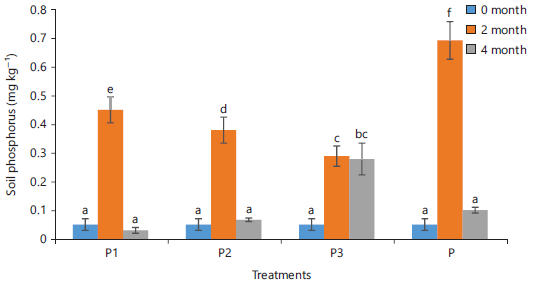
|
DISCUSSION
The alteration in soil properties caused by crude oil resulting from its spillage needs to be restored to avert other environmental and health hazards. Phytoremediation has been evaluated to be an eco-friendly and efficient method for the remediation of crude oil polluted soil.
Several plants have been reported to have phytoremediation potentials. Al-Buldawi et al.20 reported phytodegradation of TPH in diesel-contaminated water by Scirpus grossus Also the rate of phytoremediation of crude oil or other contaminants could be increased with the addition of soil amendment. It was observed that Andropogon tectorum can photodegrade crude oil contaminants in soil (with or without urea amendment).
The significant reduction in Total Petroleum Hydrocarbon (TPH) and Total Hydrocarbon Content (THC) in Andropogon tectorum phytoremediation soils (either with or without urea amendment) than in the control justifies the phytodegradation of hydrocarbons in the contaminated soil. The higher reductions in TPH and THC observed in the phytoremediation soil with urea amendment could be attributed to the urea amendment. The urea addition might have provided nutrients for the biodegradation of hydrocarbon. This is in agreement with the report of Anukwa et al.21 that the addition of fertilizer enhanced the degradation of TPH. This assertion is justifiable since the rate of degradation was directly proportional to the amount of urea (amendment) added (that is the higher the amount of fertilizer applied, the higher the rate of reduction of petroleum hydrocarbon). It is also possible that the plant might have provided a conducive environment (rhizosphere effect) for the crude oil degrading microorganisms to function. Soil properties also improved in the treated soils, either with the plant only or with a combination of plant and urea amendment. The significant increase in soil pH and conductivity observed in phytoremediation soil with urea amendment is an indication that the addition of urea provided nutrients in soil used by plants and microbes to degrade the contaminant with a subsequent decrease in soil acidity (increase in soil pH). A similar increase in soil pH in phytoremediation with urea addition has been reported by Tanee and Jude14. Atiyeh et al.22 also reported an increase in soil conductivity of crude oil polluted soil amended with inorganic fertilizer. The activities of soil microorganisms at the root zone of the plant could have contributed to the degradation of hydrocarbon and subsequent increase in the amount of water in the soil as observed in the phytoremediation soil with an amendment. The decrease in moisture content of the soil in the control could be linked to the impact of crude oil on the soil which
is in agreement with the result of Ohanmu et al.23 that crude oil in soil alters soil's physical and chemical properties. The highest total nitrogen of soil recorded in phytoremediation soil with 40 g urea amendment (P3) may be attributed to the input of nitrogen from the addition of a higher quantity of urea (a single nutrient fertilizer). An increase in TOM and TOC phytoremediation amended soil has a link with the addition of urea in phytoremediation soil as the urea supplied nutrient (nitrogen), a limiting factor in hydrocarbon biodegradation. This is contrary to the report by Tanee and Jude14 who observed a decrease in TOM and TOC of crude oil polluted soil phytoremediation soil stimulated with urea but agrees with the findings of Jude and Tanee19.
The presence of hydrocarbons in plant samples analysed shows the potential of Andropogon tectorum for petroleum hydrocarbon accumulation in their parts (shoot or root) which is one of the roles of plant in phytoremediation17. Greater accumulation observed in treatment P3 implies that a higher amount of urea amendment in soil enhanced uptake and accumulation of hydrocarbon in Andropogon tectorum. Thus, it could be deduced that high hydrocarbon accumulation by the plant was dependent on the amount of urea (amendment) added. Wang et al.24 reported a similar result of enhanced metal uptake by plants with the addition of an amendment to the soil.
CONCLUSION
Andropogon tectorum has been proven to have great potential in phytoremediation of crude oil polluted soil. However, the Addition of urea as a soil amendment in Andropogon tectorum phytoremediation soil showed a higher reduction in hydrocarbon in soil. This is an indication that phytodegradation of hydrocarbon by Andropogon tectorum in crude oil polluted soil can be enhanced by the addition of amendment (urea). Thus, to speed up phytoremediation of crude oil polluted soil, the use of amendment which serves as the source of limiting nutrients in the soil is necessary and should be adopted.
SIGNIFICANCE STATEMENT
This study discovered that the addition of urea as the amendment in Andropogon tectorum phytoremediation soil facilitates the reduction of hydrocarbon in soil. The urea amendment in soil enhanced phytodegradation of hydrocarbon by Andropogon tectorum in crude oil polluted soil. Thus a new theory of the use of a combination remediation approach involving soil amendment with urea and phytoremediation using Andropogon tectorum can be arrived at.
REFERENCES
- Umar, H.A., M.F.A. Khanan, C. Ogbonnaya, M.S. Shiru, A. Ahmad and A.I. Baba, 2021. Environmental and socioeconomic impacts of pipeline transport interdiction in Niger Delta, Nigeria. Heliyon.
- Benson, D.M., E.B. Ochekwu and F.G. Tanee, 2016. Enhancement of crude oil polluted soil by applying single and combined cow-dung and hydrogen peroxide as remediating agents. J. Appl. Sci. Environ. Manage., 20: 1137-1145.
- Agbogidi, O.M., F.U. Nweke and O.F. Eshegbeyi, 2005. Effects of soil pollution by crude oil on seedling growth of Leucaena leucocephala (Lam) De Witt. Global J. Pure Appl. Sci., 4: 453-456.
- Ite, A.E., U.J. Ibok, M.U. Ite and S.W. Petters, 2013. Petroleum exploration and production: Past and present environmental issues in the Nigeria's Niger Delta. Am. J. Environ. Prot., 1: 78-90.
- Elum, Z.A., K. Mopipi and A. Henri-Ukoha, 2016. Oil exploitation and its socioeconomic effects on the Niger Delta Region of Nigeria. Environ. Sci. Pollut. Res., 23: 12880-12889.
- Tanee, F.B.G. and E. Albert, 2015. Reconnaissance assessment of long-term effects of crude oil spill on soil chemical properties and plant composition at Kwawa, Ogoni, Nigeria. J. Environ. Sci. Technol., 8: 320-329.
- Ogbo, E.M., 2009. Effects of diesel fuel contamination on seed germination of four crop plants - Arachis hypogaea, Vigna unguiculata, Sorghum bicolor and Zea mays. Afr. J. Biotechnol., 8: 250-253.
- Emmanuel, I.O., O.D. Gordon and A.F. Nkem, 2006. The effect of oil spillage on crop yield and farm income in Delta State, Nigeria. J. Cent. Eur. Agric., 7: 41-48.
- Ossai, I.C., A. Ahmed, A. Hassan and F.S. Hamid, 2020. Remediation of soil and water contaminated with petroleum hydrocarbon: A review. Environ. Technol. Innovation.
- Kang, C.U., D.H. Kim, M.A. Khan, R. Kumar and S.E. Ji et al., 2020. Pyrolytic remediation of crude oil-contaminated soil. Sci. Total Environ.
- Fawzy, E.M., 2008. Soil remediation using in situ immobilisation techniques. Chem. Ecol., 24: 147-156.
- Ali, H., E. Khan and M.A. Sajad, 2013. Phytoremediation of heavy metals-concepts and applications. Chemosphere, 91: 869-881.
- Lee, J.H., 2013. An overview of phytoremediation as a potentially promising technology for environmental pollution control. Biotechnol. Bioprocess Eng., 18: 431-439.
- Tanee, F.B.G. and K. Jude, 2020. Stimulating the rate of phytoremediation of Chromolaena odorata in crude oil contaminated soil using inorganic urea. Int. J. Plant Soil Sci., 32: 13-25.
- O’Kelly, B.C., 2004. Accurate determination of moisture content of organic soils using the oven drying method. Drying Technol., 22: 1767-1776.
- Faustorilla, M.V., Z. Chen, R. Dharmarajan and R. Naidu, 2017. Determination of total petroleum hydrocarbons in Australian groundwater through the improvised gas chromatography-flame ionization detection technique. J. Chromatogr. Sci., 55: 775-783.
- Jude, K., F.B.G. Tanee and S.I. Mensah, 2019. Enhancing phytoremediation potential of Andropogon tectorum (Schumach & Thonn) in petroleum hydrocarbon contaminated soil using cassava peel. Sci. Afr., 18: 23-36.
- Osuji, L.C., E.J. Egbuson and C.M. Ojinnaka, 2005. Chemical reclamation of crude-oil-inundated soils from Niger Delta, Nigeria. Chem. Ecol., 21: 1-10.
- Jude, K. and F.B.G. Tanee, 2016. Remediation trials of crude oil contaminated soil using different sawdust and detergent combination levels. Sci. Afr., 15: 112-124.
- Al-Baldawi, I.A., S.R.S. Abdullah, N. Anuar, F. Suja and I. Mushrifah, 2015. Phytodegradation of total petroleum hydrocarbon (TPH) in diesel-contaminated water using Scirpus grossus. Ecol. Eng., 74: 463-473.
- Anukwa, F.A., A. Nkang, J. Nkeruwem and E.M. Onuoha, 2019. Soil amendment potential of liquid and organo-mineral fertilizer on spent engine oil-polluted soil. Res. J. Soil Biol., 12: 1-8.
- Atiyeh, R.M., S. Lee, C.A. Edwards, N.Q. Arancon and J.D. Metzger, 2002. The influence of humic acids derived from earthworm-processed organic wastes on plant growth. Bioresour. Technol., 84: 7-14.
- Ohanmu, E.O., F.A. Igiebor, S.P. Bako and I.B. Danazumi, 2018. Impact of crude oil on physicochemical properties and trace metals of soil before and after planting of two pepper species (Capsicum annum L and C. frutescens L). J. Appl. Sci. Environ. Manage., 22: 765-768.
- Wang, F., S. Zhang, P. Cheng, S. Zhang and Y. Sun, 2020. Effects of soil amendments on heavy metal immobilization and accumulation by maize grown in a multiple-metal-contaminated soil and their potential for safe crop production. Toxics.
How to Cite this paper?
APA-7 Style
Keayiabarido,
J., Tanee,
F.B., Albert,
E. (2023). Remediation Potential of Andropogon tectorum in a Crude Oil Polluted Site Amended with Urea. Trends in Applied Sciences Research, 18(1), 8-18. https://doi.org/10.3923/tasr.2023.8.18
ACS Style
Keayiabarido,
J.; Tanee,
F.B.; Albert,
E. Remediation Potential of Andropogon tectorum in a Crude Oil Polluted Site Amended with Urea. Trends Appl. Sci. Res 2023, 18, 8-18. https://doi.org/10.3923/tasr.2023.8.18
AMA Style
Keayiabarido
J, Tanee
FB, Albert
E. Remediation Potential of Andropogon tectorum in a Crude Oil Polluted Site Amended with Urea. Trends in Applied Sciences Research. 2023; 18(1): 8-18. https://doi.org/10.3923/tasr.2023.8.18
Chicago/Turabian Style
Keayiabarido, Jude, F. B.G. Tanee, and E. Albert.
2023. "Remediation Potential of Andropogon tectorum in a Crude Oil Polluted Site Amended with Urea" Trends in Applied Sciences Research 18, no. 1: 8-18. https://doi.org/10.3923/tasr.2023.8.18

This work is licensed under a Creative Commons Attribution 4.0 International License.



